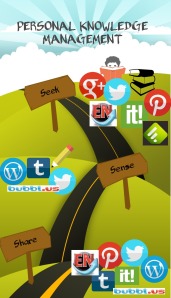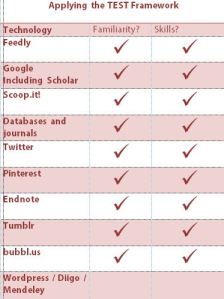I am a visual person so I am started with a rough infographic that maps out a journey or process. There is actually quite a bit of overlap or revisiting that goes on – as you can see below.
Seeking, Sensing and Sharing: My personal reflections
Feedly for aggregating content into one place. I have been using an aggregator for many years and I find it invaluable. I used to use Google Reader. This brings up an issue that its important to acknowledge. Sometimes tools disappear – and when they do you have to find an alternative that works for you – inconvenient and usually quite frustrating – it can make a mess of your hard work. I still mourn for Google Reader…..
Google generally is a big part of my knowledge seeking. This is especially so for search and Scholar.
Scoop.it! is a curation tool that allows me to subscribe to other curators with similar interests and “scoop” what I like into my own account. I find it invaluable for “keeping up” – especially in the ed tech and NGL areas.
Pinterest is great for curating visual content.
A bibliographic management tool is also a crucial part of my life. I use Endnote, have played with Zotero and am happy to explore Mendeley for this course
Twitter is great for making connections with people that have the same interests as you and for learning about topics of interest by following hashtags and people. Although I am not a daily user I couldn’t be without it now…I particularly like that it enforces concise expression.
Tumblr is my blog tool of choice and I mainly use it for sharing information with colleagues – especially post conference information that I might synthesize. I am happy to explore WordPress but I can see that it is quite sophisticated and I recognise the learning curve to come…
bubbl.us is a mindmapping tool. Again, as a visual person I find it very useful for making sense of things and mapping out my thoughts or planning my work. It has sharing functionality which I utilise when working with a group of people.
I have missed Diigo in the table below – this is my first time using it and I can see that it could be very useful. I used to be a delicious user but it was decommissioned and I havent returned since its revival – so looking forward to using Diigo as part of the course. I particularly like that sharable annotations are possible.
So overall I have a fairly embedded Personal Knowledge Management routine in my daily life. Despite this I will be adapting this routine to a new context and environment and I think this has significant implications. This will mean it takes some time for me to get my head around how this will work in this course. When I feel inertia hitting me, I keep myself moving by saying “Just do it” aloud!
Below is a table that covers the tools I have discussed above and considers my familiarity and skill levels. I think the wildcards here are environment and task.



Aug 04, 2014 @ 19:06:31
Hi Goksu,
I really like your infographic here. Looks fantastic!
What tool did you use to create this graphic? Did you use a web tool or Photoshop?
I am enjoying following your Blog. Thanks for sharing
Brendon
Aug 05, 2014 @ 08:13:58
Hello again Brendon! Looking forward to another semester of learning together!
Thank you for the compliment on my infographic and the blog. There are lots of web 2.0 infographic tools out there and they are all pretty good. The one I used in this case is called Piktochart.
Thanks for visiting.
Aug 04, 2014 @ 23:04:58
Hi Goksu,
Your name drew my attention. It is really interesting and I was wondering about its origin. Anyway, pleased to meet you in this course 😉 I had a quick read through some of your posts and found it easy to “see” what you’re saying… probably because we are both visual learners. Thank you for sharing your personal knowledge management workflow. You have laid it out very clearly… Being a graphic designer, I’m a bit fan of using image and text in such a way that ideas can jump out of the page as you read!
I have a twitter account, but up to now I have been reluctant to really use it. Hopefully this subject will help me to get my act together in the world of NGL!
Cheers, Mari
Aug 05, 2014 @ 09:06:10
Thanks Mari. Very kind. My name is Turkish (although it is very uncommon in Turkey too – there are rivers and deltas with my name in Turkey but not aware of any people!). I have been in Australia since I was a baby – so imagine Goksu with an Australian accent!
Working visually certainly helps me to make sense of things. I am glad to hear you approve – as I am a mere amateur!
In regards to Twitter and online identity: Twitter is fantastic for making connections – absolutely invaluable. With online identity – I am happy for it to be “out there” but sometimes I wonder about whether its just me that owns that identity, or does it take on a life of its own? Is there potential for corporations to take advantage of these identities? Do we need to be very mindful of these issues and make sure that people have sufficient digital literacies when negotiating the digital world? Four Corners did a program on social media and teen identity that supports some of the questions I am asking here.